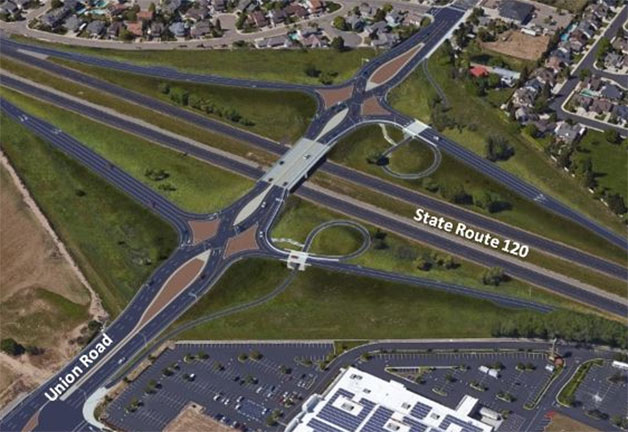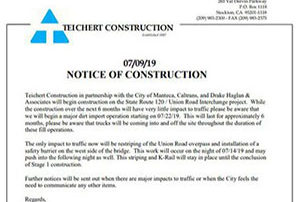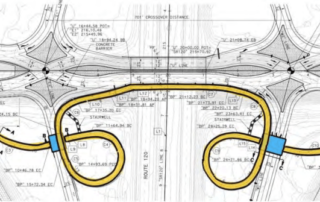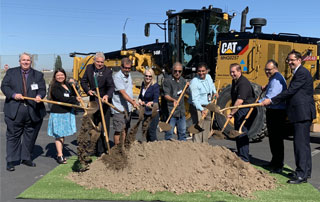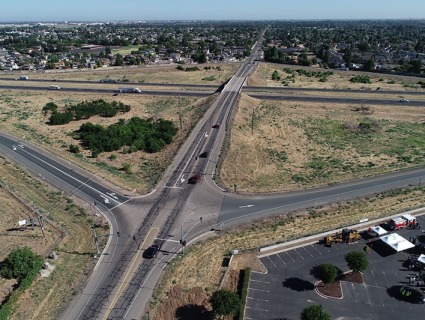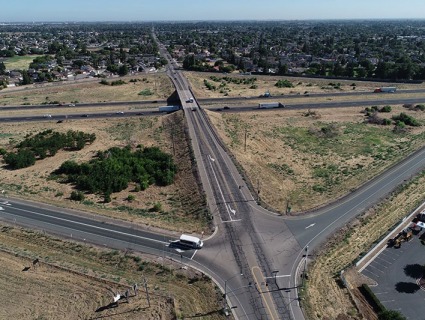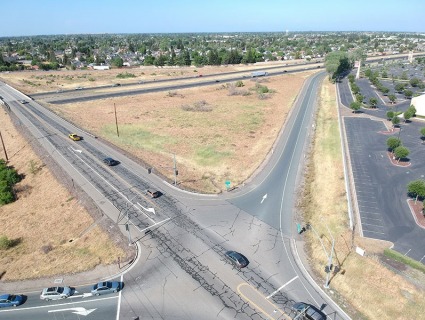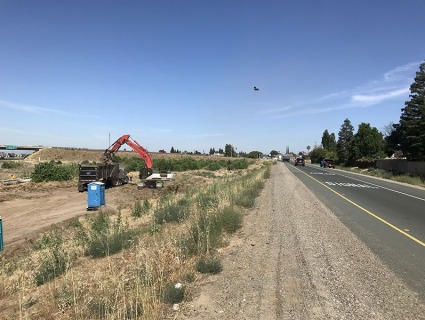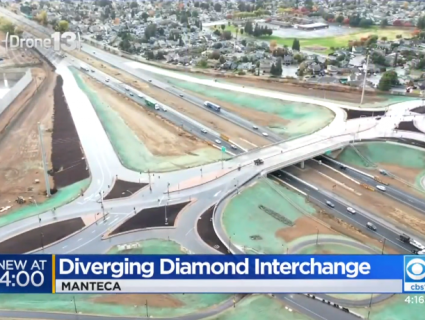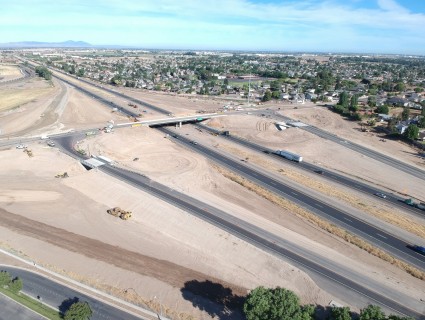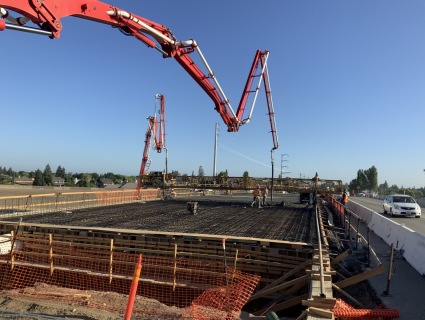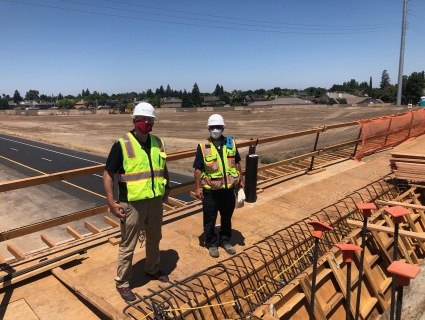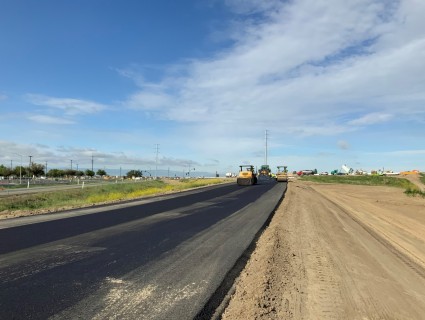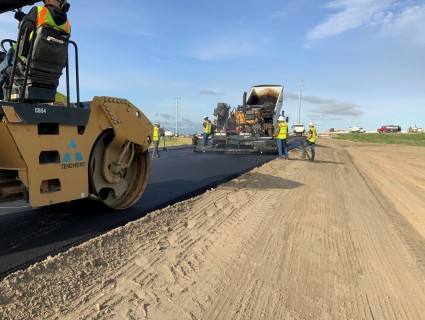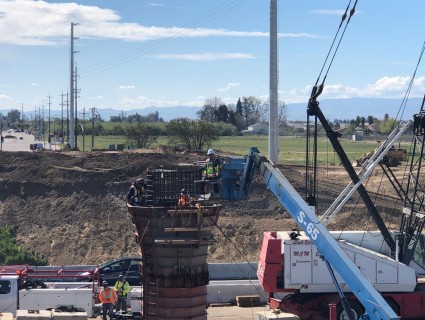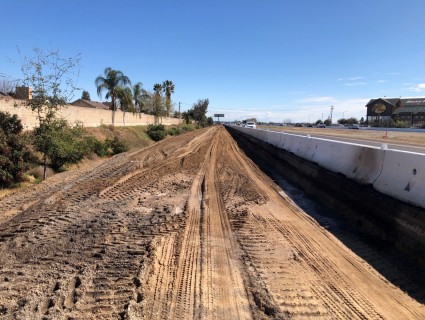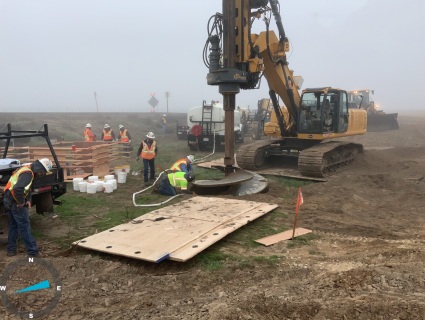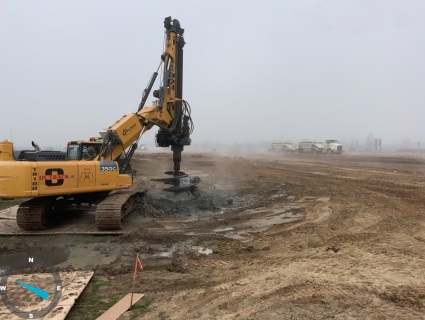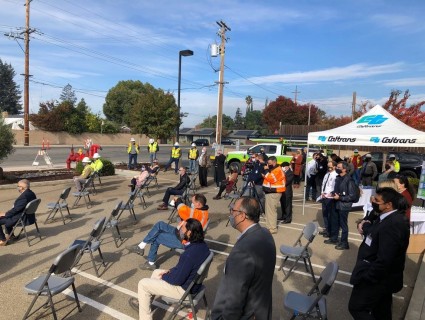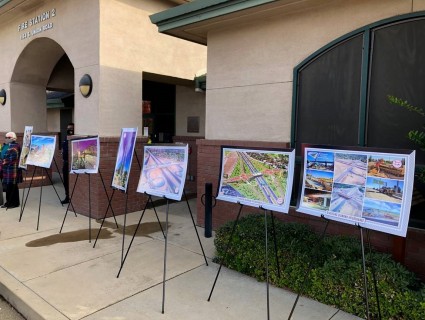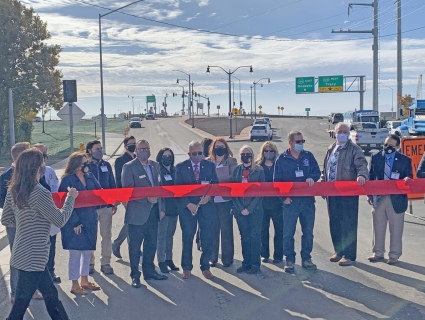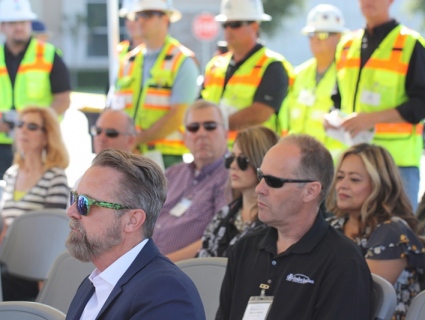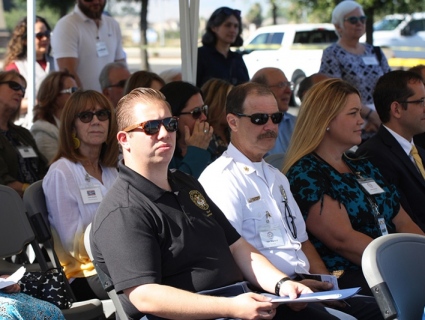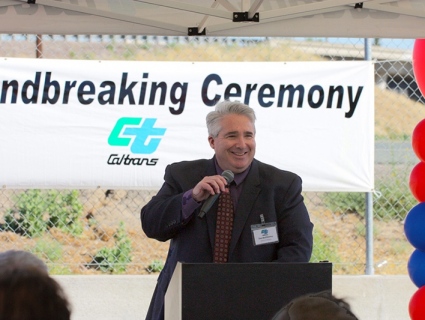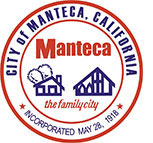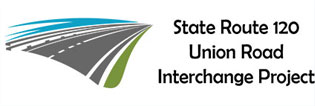Project
Description
SR120/Union Road Interchange Project
1st Diverging Diamond Interchange (DDI) in California.
1st Diverging Diamond Interchange (DDI) in California.
The City of Manteca in partnership with Caltrans District 10 and SJCOG are working to improve safety and traffic flow at interchange located at State Route 120 and Union Road. The project will improve safety conditions by constructing new on and off ramps, widening Union Road to 4 lanes between Daniels Street and Lifestyle Street, and providing a Class I shared-use path and Class II bike lanes.
The new interchange reduces conflict points between vehicles and moves traffic more efficiently through the interchange. The DDI is unique in that traffic on the local road is shifted to the left side of the road, before being shifted back to the right. Eliminating any left hand turns through the intersection. Upgrading to the unique DDI configuration provides significant cost savings and safety benefits for both vehicles and pedestrians.
Union Road is a key crossing of State Route 120 in the City’s bicycle master plan. The new Class I path will provide a 10-foot wide grade-separated trail that eliminates all bicycle/vehicle conflict points within the interchange to provide safe and efficient passage for bicycles, pedestrians, and other non-motorized travel.
Auxiliary lanes will be constructed between Airport Way and Main Street on eastbound and westbound State Route 120 to provide for increased traffic flow during peak times.
Benefits of a
Diverging Diamond Interchange (DDI)
Diverging Diamond Interchange (DDI)
Safety is a priority. This Diverging Diamond Interchange will reduce the number of conflict points from the existing 26 down to 14. Most importantly, the more severe collision types (crossing/T-bone) are reduced form 10 down to two.
Existing overpass does not have designated pedestrian or bicycle access. The new interchange will provide a Class I shared-use path and Class II bike lanes. The new Class I path will provide a 10-foot wide grade-separated trail that eliminates all bicycle/vehicle conflict points within the interchange providing safe and efficient passage for bicycles, pedestrians, and other non-motorized travel.
Cost effective solution allows for the project costs to be greatly reduced compared to other interchange types. Also allows for the existing bridge to remain.
Improved traffic operations on Union Road. This project will construct auxiliary lanes on State Route 120 from Airport Way to Main Street.
Compact footprint by eliminating right of way acquisition.
Class I grade separated shared use path improves pedestrian and bicycle mobility. This accomplishes the City’s General Plan goal and closes a significant gap in the pedestrian network.
Safety is highly increased with a DDI due to a reduction in collision points from 26 to 14 and separate bicycles and pedestrian lanes.
Construction
Schedule
Project Schedule
| June 25, 2019 | Groundbreaking Event |
| July 2019 | Construction Begins |
| November 25, 2020 | New DDI opens |
Project Notes
- Delays are anticipated weekdays between 6:00am – 4:00pm on Union Road between Atherton Drive and Daniels Street. Please be aware of increased truck traffic in the area as a result of the interchange improvements.
- Traffic Detours and Closures will be posted in advance on this website in the Updates Section and the City of Manteca Facebook Page.
- Work will generally take place between 6 a.m. and 5 p.m. Monday through Friday. Night and/or weekend work may occur as necessary.
Project Hotline: 209.707.3470
Project
Updates
Construction Begins July 8, 2019

Weather permitting, SR120/Union Rd Interchange construction will begin Monday, July 8th. We are expecting recurrent lane/shoulder closures and one lane reversing traffic control in the project area. The lane closures will continue intermittently throughout the 1-year construction and will typically take place between 6:30am and 5:00pm Monday through Friday, with the full roadway being re-opened each afternoon. Emergency vehicles will be allowed through the construction site and we will have a plan for traffic control personnel to follow in the event that these vehicles need to pass through during the lane closure.
Central Valley to Get a Diverging Diamond Interchange
California’s first Diverging Diamond Interchange (DDI), a traffic design engineers say will reduce collisions and improve traffic flow, is coming to the Central Valley.
The DDI will replace an existing interchange on SR 120 at Union Road in Manteca, in San Joaquin County. That part of the city contains a popular shopping and entertainment center, as well as new housing development, and more growth is expected into the future. Improvements at this crossing have been in various planning stages for over fifteen years.
A recent groundbreaking ceremony marked the beginning of construction on the DDI, and it is expected to be completed by the end of 2020.
The DDI, said Caltrans District 10 Director Dan McElhinney at the groundbreaking, “slows everybody down but gets everybody mobile.” That is, it keeps cars moving through a complicated merging pattern instead of requiring them to stop at an old-fashioned intersection.
It also avoids interactions between cars and other road users by removing pedestrians and bicyclists from the roadway. Instead, engineers will build a long, looping, separated path for them, dropping down into a short tunnel to cross under the road and then climbing up to the interchange to cross over the highway at the same level as vehicle traffic.
The basic concept of a DDI is that motorists enter from the right side of the road, cross over to the left side as they go through the interchange, and then cross back again to the right to exit (see a simulation here). Engineers love the design because it supposedly improves traffic flow by removing the need for traffic signals at on and off ramps. They also say its diverging diamond shape will prevent congestion by reducing stopping points.
Koosun Kim, deputy director of Public Works for the city of Manteca, said one of the main reasons that a DDI design was chosen is because it is expected to reduce collisions. The existing interchange has 26 potential conflict points; the DDI design has only fourteen of them.
While proponents of DDIs tout safety for car occupants, others say that they demonstrate blindness to the actual experience of bicyclists and pedestrians trying to get across.
Kim said concern for the safety of pedestrians and bicyclists is why the city decided to build a separate path for them.
“If you look at what it’s like right now–it’s very dangerous for children,” he said. There is a school located on one side of the existing interchange and a shopping center and movie theater on the other. Children often cross the interchange on the only currently available space, which is the shoulder.

Usually DDIs locate pedestrian walkways in the median or along the sides of the road, and place bicycle lanes next to vehicle traffic. The Manteca DDI will instead include a separate twelve-foot-wide bridge on the east side of the overpass. To get through the interchange, pedestrians and bicyclists will have to drop down from street level, follow a tunnel under the freeway ramps, then climb upward on a circular path to the bridge, where they will cross over with vehicle traffic, but behind some kind of barrier. Then they will have to repeat the sequence, backwards, on the other side, as illustrated in the top image.
A staircase will be provided as a shortcut for pedestrians who want to avoid the longer ADA-compliant loop. Security measures, including cameras, lighting, and emergency call buttons, will be added to the tunnel.
The design is inspired by one at Highway 50 and Watt Avenue near the American River in Sacramento.
For bicyclists and pedestrians, the trip across the interchange will be about twice as long as it is for vehicles, and that much longer than the current, dangerous shoulder crossing.
The project will also encourage more and faster vehicle traffic in other ways. It will widen SR 120, building “auxiliary lanes” from Airport Way to Main Street, and widen Union Road to four lanes between Daniels and Lifestyle streets.
The city of Manteca is fully funding the project with a combination of Redevelopment Agency funds (the interchange improvement was assigned RDA money before the agency was dissolved), local development fees, and Measure K, the half-cent sales tax approved by San Joaquin County voters.
DDIs have been built around the country, but this will California’s first. Manteca’s design is expected to be the model for other California cities that are considering similar construction projects. There are at least four in the works: in Modesto, San Bernardino, Ceres, and San Diego.
Caltrans hopes so. “We hope to see many more like this,” McElhinney said at the groundbreaking.
Source: June 28, 2019, Minerva Perez, STREETSBLOGCAL
“Central Valley to Get a Diverging Diamond Interchange”
https://cal.streetsblog.org/2019/06/28/central-valley-to-get-a-diverging-diamond-interchange/
Ground Breaking Ceremony
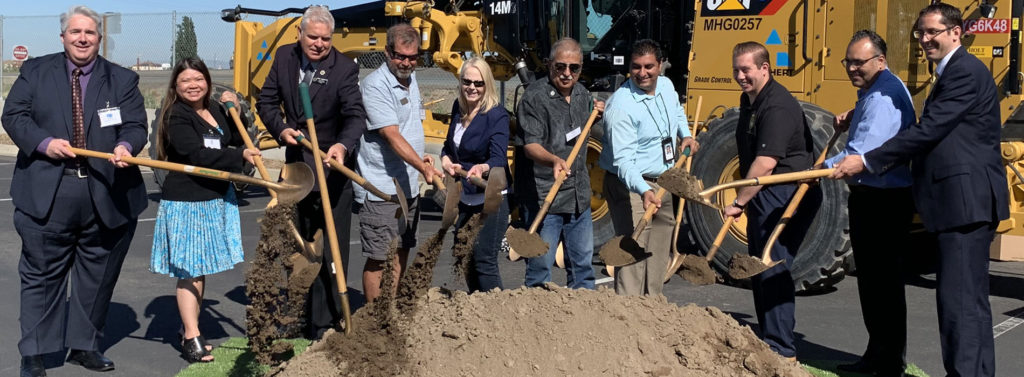
Pictured Left to Right: Mike Anderson representative for Tom Patty, Melissa Santos on behalf of Josh Harder, Dan McElhinney District 10 Director, Deputy Mayor David Breitenbucher, Counci member Debbie Moorehead, Mayor Ben Cantu, Councilmember Gary Singh, Assembly Representative, Jason F. Laughlin, Council member Vince Hernandez, City Manager Tim Ogden
Better Bypass Movement – Manteca Bulletin
Commuters on the 120 Bypass will appreciate Manteca building California’s first diverging diamond interchange at Union Road even if they never drive across the bridge deck where travel lanes cross each other twice to improve flow and reduce the potential for accidents.
That’s because the $23.7 million project includes constructing auxiliary lanes from Union Road along the 120 Bypass to both Airport Way and Main Street in both directions to allow a much smoother weave in and out of freeway traffic. Ramp metering signals will also be installed.
The auxiliary lanes will help ease some of the stop-and-go congestion that plagues the 120 Bypass that is the deadliest and most accident prone stretch of freeway in the Northern San Joaquin Valley where, on average, an accident is happening almost every day.
The City Council on Tuesday is expected to award a $23.7 million contract to Teichert to do the work. The four bids ranging from $23.7 million and $29.6 million came in over the engineer’s estimate of $20 million. The second lowest bid by DeSilva Gates Construction was just under $53,000 more than the Teichert bid. When the council meets at 7p.m. at the Civic Center, 1001 W. Center St., they are also being asked to award a $2.3 million contract to Drake Haglan & Associates for construction management and inspection services. That is in addition to a $604,729 contract with Mark Thomas & Company for construction staking and support services.
To allow the project to go forward staff is recommending switching $2.2 million of the funds set aside to build an interchange at McKinley Avenue and the 120 Bypass as well as $1,225,000 budgeted to extend Milo Candini Drive from where it now ends at the northern edge of the Big League Dreams sports complex to Yosemite Avenue to the project.
The project will also allow a left turn lane to access The Promenade Shops at Orchard Valley from southbound Union Road midway between the interchange and Atherton Drive in front of JC Penney. That would allow motorists to access Bass Pro Shops, AMC Theatres and other stores from the interior road that runs along the 120 Bypass.
It also includes Manteca’s first freeway overcrossing designed exclusively for pedestrians and bicycles. A separate 12-foot wide bridge will be built to the east of the overpass with access to the bridge being via tunnels passing under off and on ramps with an ADA compliant loop leading up and down from the bridge. That will get pedestrian bicycle traffic away from the bridge deck.
The separate pedestrian crossing was the result of adamant pressure four years ago from Councilwoman Debby Moorhead and then Councilman Vince Hernandez and former Mayor Steve DeBrum who were growing frustrated with pedestrian safety in Manteca. It was the same year Manteca recorded two pedestrian fatalities.
Hernandez was perhaps the most passionate as he repeatedly pointed out fairly large numbers of people on foot and bicycle — many of them students — cross the 120 Bypass via bridges that have neither sidewalks, barriers separating them from traffic or fencing to prevent falls to the freeway below.
Staff not only came up with the solution but was able to secure Measure K sales tax funds to pay for the separate pedestrian bridge.
The fact two tunnels beneath ramps are involved prompted staff to think of possible safety concerns. In some cities where such pedestrian tunnels are in place they have become spots after dark for criminal acts and for the homeless to bed down.
As a result the tunnels will have:
Security cameras placed and protected so they can’t be damaged to provide live feeds backs to the Manteca Police Dispatch Center.
There will be extensive lighting that will also be placed and protected in a manner where they can’t be damaged.
There will be a 24-hour emergency button tied in directly to the 9-1-1 system.
It will be equipped with a device that emits continuous noise that is extremely uncomfortable to hear for an extended period of time.
Why the diverging diamond design was selected by Manteca:
The diverging diamond approach was recommended by Public Works Department staff after they were tasked by elected leaders to try and come up with the most cost effective upgrade for the interchange.
The only other requirement was to move larger volumes of traffic.
Originally the plans called for a half cloverleaf that would have required taking nearby property including several homes.
Staff looked into diverging diamond designs that were deployed in other states that were selected not for cost savings as much as it was to place interchanges that worked effectively in developed areas without taking more land and to improve safety.
In the case of Manteca the design means a project price tag that was $10 million less as no additional land was needed. Also a cloverleaf style interchange would have required demolition work resulting in a longer construction frame.
As an added bonus the design allows for faster and smoother traffic flow and — based on observations of diverging diamond interchanges in place — less severe collisions as well as fewer accidents.
Caltrans District 10 has helped clear the way for the design that has been deployed in 80 plus other locations in the country — with the nearest being on Mona Lane in Reno
With a diverging diamond interchange the flow across the freeway has lanes crossings to the opposite side of Union Road where the ramps are and then crossing back over at the ramps on the other side of the bridge.
Where the traffic crisscrosses they are traffic signals. On a traditional overpass turn movements on and off the freeway would also go through the traffic signals. That’s not the case with a diverging diamond interchange.
If Union Road was improved to a partial cloverleaf interchange as was originally envisioned there would be 24 conflict points for vehicles. The diverging diamond has 12.
Even more significant is the reduction in the potential for frequent T-Bone crashes that can result in extensive property damage and serious injury. There are 20 such conflicts on a traditional interchange and just two on a diverging diamond. Those two would be where the north and south lanes on Union Road crisscross.
Due to the interchange’s geometry the average speed is slowed from 40 mph to 25 mph.
Source: March 1, 2019, Dennis Wyatt, Manteca Bulletin
“Better Bypass Movements”
https://www.mantecabulletin.com/news/local-news/better-bypass-movements/
JOIN OUR MAILING LIST
Keep Up-To-Date on Project Details
Fill in the form below to be added to our newsletter.

